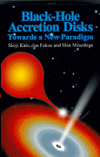Home > Book Detail Page

Since publication of the first edition, models of advection-dominated accretion flows and their comparison with observations have been much developed and deepened, including the cases of super-Eddington accretion. The launch of the Rossi X-ray Timing Explorer led to the discovery of high-frequency oscillations, which opened a new field of discoseismology. In addition, development of observational techniques show that the time when we see a direct image or silhouette of black holes is in the near future. Considering these situations, we fully revised the first edition in order to meet the developments mentioned above.
Preface
Contents
Part Ⅰ Concepts of Accretion Disks
Chap.1 Introduction
1.1 Accretion Energy -- Historical Origin
1.2 Accretion-Disk Paradigm -- Active Universe
1.3 Accretion-Powered Objects -- Observational Reviews
1.4 X-Ray Binaries and Ultra-Luminous Sources
1.5 Active Galactic Nuclei
1.6 Present Paradigm
Chap.2 Physical Processes Related to Accretion
2.1 Eddington Luminosity
2.2 Bondi Accretion
2.3 Viscous Process
2.4 Magnetic Instabilities
2.5 Relativistic Effects
Part Ⅱ Classical Picture
Chap.3 Classical Models
3.1 Viscous Accretion Disks
3.2 Standard Disks
3.3 Optically Thin Disks
3.4 Accretion Disk Coronae
3.5Relativistic Standard Disks
3.6 Relativistic Tori
Chap.4 Secular and Thermal Instabilities
4.1 Secular Instability
4.2 Thermal Instability
4.3 Stability Examination on Ṁ-Σ and T-Σ Planes
4.4 Mathematical Derivation of the Stability Criterion
Chap.5 Dwarf-Nova Type Instability
5.1 Thermal-Ionization Instability
5.2 Time Evolution of Disks in X-Ray Novae
Chap.6 Observability of Relativistic Effects
6.1 Ray Tracing
6.2 Imaging -- Black Hole Silhouette
6.3 Spectroscopy -- Continuum and Line
6.4 Photometry -- Light Curve Diagnosis
6.5 Other Effects -- Lensing and Jets
Part Ⅲ Modern Picture
Chap.7 Equations to Construct Generalized Models
7.1 Basic Equations and Importance of Advection
7.2 One-Temperature Disks
7.3 Two-Temperature Disks
7.4 Time-Dependent Equations
Chap.8 Transonic Nature of Accretion Flows
8.1 Topology of Black-Hole Accretion
8.2 Regularity Condition at a Critical Radius
8.3 Topology around the Critical Radius in Isothermal Disks
8.4 Numerical Examples of Transonic Flows
8.5 Transonic Flows with Standing Shocks
Chap.9 Radiatively Inefficient Accretion Flows
9.1 Advection- Dominated Accretion Flow
9.2 Radial Structure of Advection-Dominated Flow
9.3 Radiation Spectra of Advection-Dominated Flow
9.4 Stability of Advection-Dominated Flow
9.5 Multi-Dimensional Effects
Chap.10 Slim Accretion Disks and Supercritical Flows
10.1 Photon Trapping and Slim Disk Model
10.2 Radial Structure of Slim Disks
10.3 Radiation Spectra of Slim Disks
10.4 Relaxation Oscillations in Hot Accretion Disks
10.5 Multi-Dimensional Effects of Supercritical Flow
10.6 Neutrino-Cooled Disks
Part Ⅳ Oscillations and Waves
Chap.11 Fundamentals of Disk Oscillations
11.1 Classification of Disk Oscillations
11.2 Basic Equations
11.3 Dispersion Relation and Basic Properties
11.4 One-Armed Low-Frequency Global Oscillations
11.5 Amplification of Disk Oscillations by Viscosity
Chap.12 Quasi-Periodic Oscillations
12.1 Observations of Quasi-Periodic Oscillations
12.2 Sonic-Point Instability and Trapped Oscillations
12.3 Resonant Oscillations in Warped Disks
12.4 Comparison of Warp Models with Observations
12.5 Other Disk-Oscillation Models of QPOs
Appendix
A Kerr Metric and its Basic Properties
B Navier-Stokes Equations
C Equations for Relativistic Viscous Fluid
D Radiative Transfer Equations
E Equations for Relativistic radiation Hydrodynamics
F Magnetohydrodynamical Equations
G Equations for Relativistic Magnetohydrodynamics
H Relativistic Equation of State
I Cooling of Relativistic Gas
List of Symbols
Index
Credits
Contents
Part Ⅰ Concepts of Accretion Disks
Chap.1 Introduction
1.1 Accretion Energy -- Historical Origin
1.2 Accretion-Disk Paradigm -- Active Universe
1.3 Accretion-Powered Objects -- Observational Reviews
1.4 X-Ray Binaries and Ultra-Luminous Sources
1.5 Active Galactic Nuclei
1.6 Present Paradigm
Chap.2 Physical Processes Related to Accretion
2.1 Eddington Luminosity
2.2 Bondi Accretion
2.3 Viscous Process
2.4 Magnetic Instabilities
2.5 Relativistic Effects
Part Ⅱ Classical Picture
Chap.3 Classical Models
3.1 Viscous Accretion Disks
3.2 Standard Disks
3.3 Optically Thin Disks
3.4 Accretion Disk Coronae
3.5Relativistic Standard Disks
3.6 Relativistic Tori
Chap.4 Secular and Thermal Instabilities
4.1 Secular Instability
4.2 Thermal Instability
4.3 Stability Examination on Ṁ-Σ and T-Σ Planes
4.4 Mathematical Derivation of the Stability Criterion
Chap.5 Dwarf-Nova Type Instability
5.1 Thermal-Ionization Instability
5.2 Time Evolution of Disks in X-Ray Novae
Chap.6 Observability of Relativistic Effects
6.1 Ray Tracing
6.2 Imaging -- Black Hole Silhouette
6.3 Spectroscopy -- Continuum and Line
6.4 Photometry -- Light Curve Diagnosis
6.5 Other Effects -- Lensing and Jets
Part Ⅲ Modern Picture
Chap.7 Equations to Construct Generalized Models
7.1 Basic Equations and Importance of Advection
7.2 One-Temperature Disks
7.3 Two-Temperature Disks
7.4 Time-Dependent Equations
Chap.8 Transonic Nature of Accretion Flows
8.1 Topology of Black-Hole Accretion
8.2 Regularity Condition at a Critical Radius
8.3 Topology around the Critical Radius in Isothermal Disks
8.4 Numerical Examples of Transonic Flows
8.5 Transonic Flows with Standing Shocks
Chap.9 Radiatively Inefficient Accretion Flows
9.1 Advection- Dominated Accretion Flow
9.2 Radial Structure of Advection-Dominated Flow
9.3 Radiation Spectra of Advection-Dominated Flow
9.4 Stability of Advection-Dominated Flow
9.5 Multi-Dimensional Effects
Chap.10 Slim Accretion Disks and Supercritical Flows
10.1 Photon Trapping and Slim Disk Model
10.2 Radial Structure of Slim Disks
10.3 Radiation Spectra of Slim Disks
10.4 Relaxation Oscillations in Hot Accretion Disks
10.5 Multi-Dimensional Effects of Supercritical Flow
10.6 Neutrino-Cooled Disks
Part Ⅳ Oscillations and Waves
Chap.11 Fundamentals of Disk Oscillations
11.1 Classification of Disk Oscillations
11.2 Basic Equations
11.3 Dispersion Relation and Basic Properties
11.4 One-Armed Low-Frequency Global Oscillations
11.5 Amplification of Disk Oscillations by Viscosity
Chap.12 Quasi-Periodic Oscillations
12.1 Observations of Quasi-Periodic Oscillations
12.2 Sonic-Point Instability and Trapped Oscillations
12.3 Resonant Oscillations in Warped Disks
12.4 Comparison of Warp Models with Observations
12.5 Other Disk-Oscillation Models of QPOs
Appendix
A Kerr Metric and its Basic Properties
B Navier-Stokes Equations
C Equations for Relativistic Viscous Fluid
D Radiative Transfer Equations
E Equations for Relativistic radiation Hydrodynamics
F Magnetohydrodynamical Equations
G Equations for Relativistic Magnetohydrodynamics
H Relativistic Equation of State
I Cooling of Relativistic Gas
List of Symbols
Index
Credits










